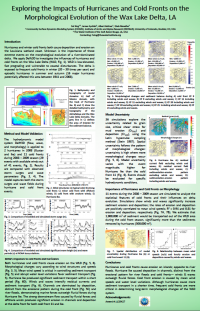CSDMS 2015 annual meeting poster FeiXing
Exploring the Impacts of Hurricanes and Cold Fronts on the Morphological Evolution of the Wax Lake Delta, LA
James Syvitski, CSDMS, INSTAAR, Univ. of Colorado, Colorado, United States.
Albert Kettner, CSDMS, INSTAAR, Univ. of Colorado, Colorado, United States.
Ehab Mesehle, The Water Institute of the Gulf, Louisiana, United States.
Abstract:
Tropical cyclones (e.g. hurricane) and winter cold fronts are the two major weather systems influencing morphology of the coastal wetlands along the Gulf of Mexico. Delft3D is applied to the Wax Lake Delta (WLD), Louisiana, to study the impact of coastal storms with different magnitudes and frequencies on wetland morphology. Our simulations of a strong cold front (mean wind speed of 11.4 m/s) and a single hurricane event (Hurricane Ike, made landfall 337 km to the west of the WLD as a Category 2 Hurricane) demonstrate that although the hurricane event causes more sediment transport, many similarities exist between the two events: winds and waves significantly increase the amount of sediment transport; erosion occurs on islands; negative sediment balance for the WLD system (erosion). The simulations of 11 cold fronts between the 2008-2009 season show that cold fronts that cause significant water level variations produce stronger residual currents and move more sediment than events that causes minor water level variations, and that mean wind speeds are positively correlated with hourly averaged erosion and deposition caused by winds and waves (R2 of 0.94 for erosion, and 0.81 for deposition). The relationships are applied to 29 cold front events with available wind data (in total 41 events were recognized for the season), leading to a cumulatively erosion of 1,900,000 m3 on the WLD, higher than a single hurricane event such as Ike (412,000 m3). The results illustrate that cold fronts are more critical in determining deltaic morphology than a single hurricane event. Vegetation that grows in hurricane season significantly decreases the amount of erosion (from 412,000 m3 to 308, 000 m3 for hurricane Ike). Saline water intrusion threatens the survival of freshwater species on the WLD during hurricane events but would not influence the species during most of cold front events.
* Please acknowledge the original contributors when you are using this material. If there are any copyright issues, please let us know and we will respond as soon as possible.

